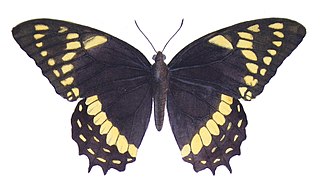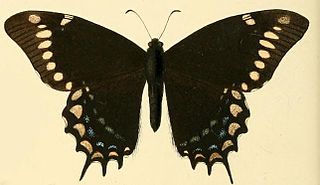
Papilio is a genus in the swallowtail butterfly family, Papilionidae, as well as the only representative of the tribe Papilionini. The word papilio is Latin for butterfly.

Papilio bachus is a butterfly of the family Papilionidae. It is found in South America, including Colombia, Ecuador, Peru, and Bolivia.

Papilio cacicus is a Neotropical butterfly of the family Papilionidae first described by Hippolyte Lucas in 1852. It is found in Colombia, Venezuela, Ecuador and Peru.

Papilio menatius is a butterfly of the family Papilionidae.

Papilio isidorus is a butterfly of the family Papilionidae (swallowtails). The species was first described by Henry Doubleday in 1846. It is found in Central and South America.

Papilio zagreus is a butterfly of the family Papilionidae (swallowtails). It is found in South America, including Venezuela, Colombia, Ecuador, Peru, Bolivia and western Brazil.

Papilio birchallii is a species of Neotropical swallowtail butterfly from the genus Papilio that is found in Colombia, Panama and Costa Rica.

Papilio garamas, commonly known as the mexico phoenix or magnificent swallowtail, is a species of Neotropical swallowtail butterfly found in Mexico, Guatemala, Honduras, Panama and Costa Rica.

Papilio hellanichus is a species of Neotropical swallowtail butterfly from the genus Papilio that is found in Brazil, Uruguay and Argentina.

Papilio hornimani, the Hornimans green-banded swallowtail or Horniman's swallowtail, is a species of swallowtail butterfly from the genus Papilio that is found in the highland forests of Kenya and Tanzania.

Papilio pelaus, the prickly ash swallowtail, is a species of Neotropical swallowtail butterfly from the genus Papilio that is found in Jamaica, Hispaniola, Cuba and Puerto Rico.

Papilio neyi is a species of swallowtail butterfly from the genus Papilio that is found in Ecuador, French Guiana, Peru and Brazil.

Papilio xanthopleura is a species of swallowtail butterfly from the genus Papilio that is found in Peru and Brazil.

Papilio warscewiczii is a Neotropical species of swallowtail butterfly from the genus Papilio that is found in Peru, Bolivia and Ecuador.

Mimoides pausanias, the Pausanias swallowtail or bluish mimic-swallowtail, is a species of butterfly in the family Papilionidae.

Parides lysander, the Lysander cattleheart, is a species of butterfly in the family Papilionidae. It is found in the Neotropical realm.

Parides orellana is a species of butterfly in the family Papilionidae. It is found in the Neotropical realm..

Parides phosphorus is a species of butterfly in the family Papilionidae. It is found in the Neotropical realm.

Eurytides serville is a species of butterfly found in the Neotropical realm.

Protesilaus molops is a species of butterfly found in the Neotropical realm.




















